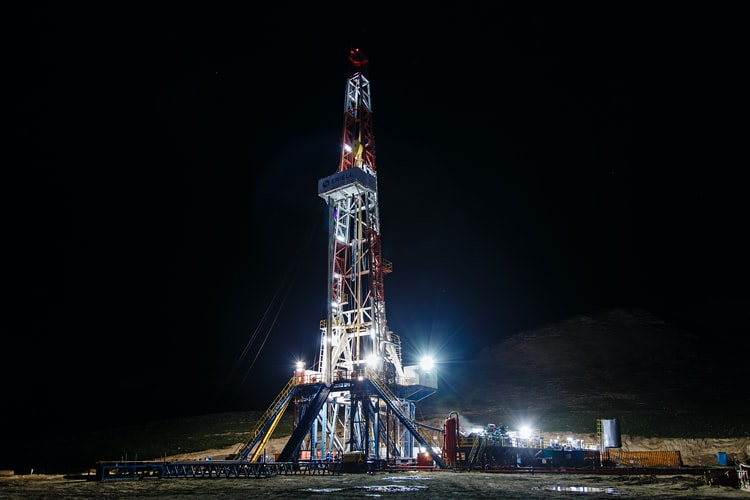
As the energy landscape undergoes rapid transformation, staying ahead of oil and gas industry trends is more critical than ever. From the push toward sustainability and digital innovation to evolving global energy demands, the industry is facing both disruption and opportunity.
Whether you're navigating regulatory changes or seeking to improve operational efficiency, understanding these trends will help you make smarter strategic decisions in 2025 and beyond. In this article, we explore the key developments shaping the future of oil and gas and what they mean for industry leaders, engineers, and quality professionals alike.
The oil and gas industry is still miles behind digital transformation. According to Deloitte’s Digital Maturity Index, the oil and gas sector scores just 1.3 on the Deloitte scale – the lowest of all industry verticals.
With such a low score, businesses cannot afford to continue operating inefficiently due to declining natural resources and consumer demand for cleaner energy. Hence, disruptive technologies are gaining momentum among oil and gas companies.
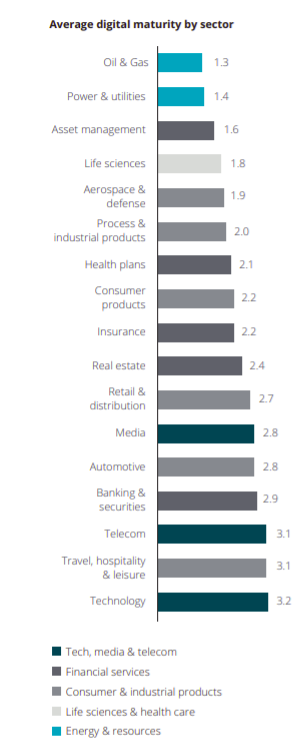
(Image source: deloitte.com)
New Technology in the Oil and Gas Industry
Businesses are now moving away from traditional structures and adopting technology to stay ahead of cutthroat competition. As a result, technologies such as rig inspection applications, artificial intelligence, robotics, the Internet of Things (IoT), big-data analytics, and enhanced cybersecurity are gaining traction.
The benefits of leveraging technology within the oil and gas sector far outweigh the initial investment costs. For example, McKinsey estimates companies stand to save operational costs by 20 to 25% per barrel through data analytics and reliance on deep-water connectivity technology.
In Canada, the United States, and Norway, fiber connectivity accounts for 40% of offshore production volume, showing that there's enough capacity to create high-capacity coverage to improve connectivity in crewless vessels. Such insights portray a promising outlook for oil and gas companies that are still hesitant to apply modern technology to their operations.
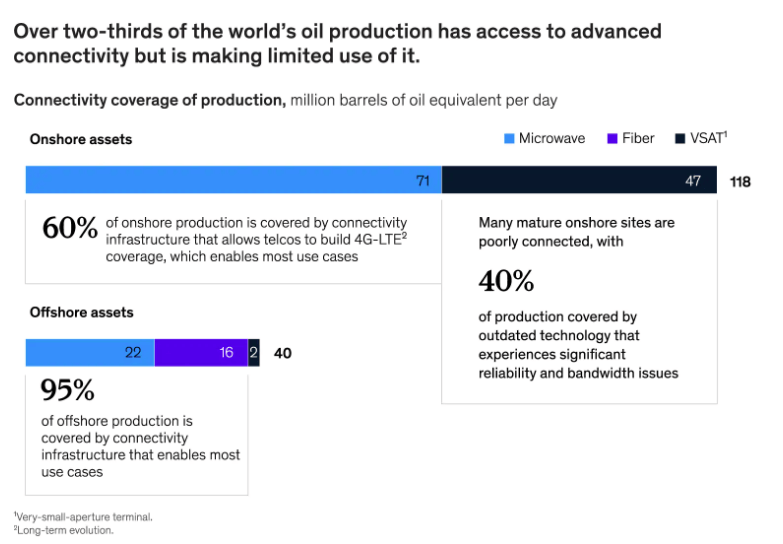
(Image source: mckinsey.com)
Below, we highlight the leading trends in resource efficiency, operational costs, business execution, connectivity, security, and workplace user experience.
1. Workplace Digital Transformation
Digital transformation re-imagines how work gets done through investing in collaboration tools, re-skilling talent, and adopting a digital-first workplace culture. Companies need to develop an inclusive and agile approach to transforming their organization digitally.
It's not enough to implement digital tools and solutions to solve existing problems; businesses need to review which functions require technology to deliver more value, then invest in the right mix of talent, tools, and structures.
The best approach is to implement the strategy incrementally while infusing an agile approach to get the most value out of your transformation process. Each company within the oil and gas industry requires a diverse set of digital assets, and none can have the same outcome. The key takeaway to actualizing a digital-first workplace that delivers value is to create a sound strategy and implement a holistic mix of solutions while measuring the value they add at each stage of implementation.
2. Increased Use of Artificial Intelligence
Artificial Intelligence's (AI) primary goal in the oil and gas upstream, midstream, and downstream operations is to reduce risks, improve efficiency, and extract more value from resources by using advanced technology. The upstream section within the industry focuses on natural gas and crude oil production and is the most capital-intensive segment within the oil and gas business.
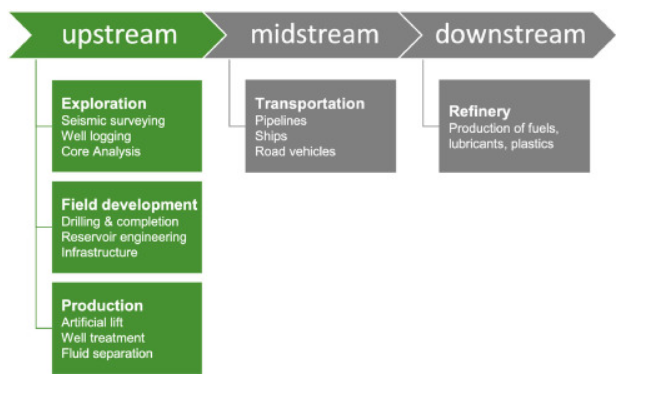 (Image source: sciencedirect.com)
(Image source: sciencedirect.com)
A combination of AI algorithms and machine learning saves up to 15%-20% in financial and time resources in well construction through real-time drilling telemetry. In addition, neural networks in artificial intelligence are now applied in reservoir engineering to accelerate conventional simulations and identify the most optimal field development scenarios.
Advanced AI imaging tools accelerate exploration by applying high-performance computing and algorithms to speed up the reconstruction of 3D images collected from seismic surveying. The result is a lower cost of seismic-related operations and more accurate recommendations of oil field operations.
Companies applying AI-powered tools will register lower production costs, especially in upstream operations, creating higher profitability and lower prices for consumers who purchase the end-products.
3. Automation
Automation in the oil and gas industry creates safer work environments by removing manual work processes and accelerating operations. For example, automating drilling processes such as pressure drilling and pipe handling reduces costs and improves safety.
Most mining fields are located in remote areas, so using drones eliminates the need to hire pilots and reduces the cost of inspections and drilling operations.
Automation also plays a part in security by monitoring oil pipelines using crewless vehicles and subsea cameras to prevent theft and attacks. Such trends will continue to improve worker safety and prevent malicious attacks on oil and gas companies.
4. IIoT Digital Technologies
Industrial Internet of Things (IIoT) applies actuators, intelligent sensors, and edge nodes to detect inefficiencies, identify machinery problems, and track assets. Such advanced technology holds potential for improving quality, tracing supply chain processes, and relaying data quickly for faster decision-making.
The Oil and Gas industry has long relied on human effort to track and enhance industrial activities. Still, with the refinement of IIoT, these devices will deliver more accurate data to improve predictive maintenance (PdM) and reduce the cost of equipment servicing.
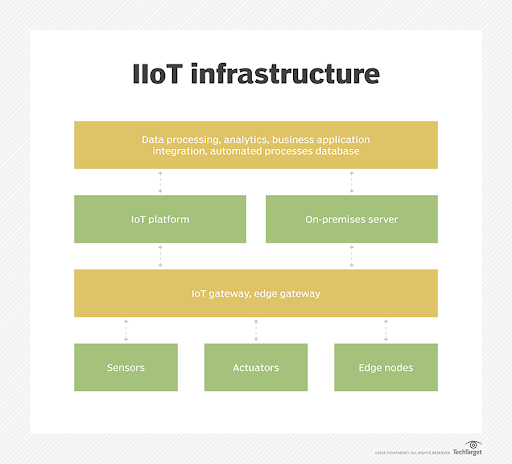
(Image source: techtarget.com)
5. Machine Learning and Data Analytics
Big data analytics allows companies to shift their business models from "production at all costs" and predict profits and losses more accurately. In addition, such capabilities will help oil and gas businesses navigate market fluctuations and consumer behavior to better plan their drilling operations.
This shift to data analysis to predict the future will help oil and gas companies restructure themselves to meet increasing demand in clean energy while retaining profitability.
By using advanced predictive and cognitive analytics, companies can optimize rig maintenance and rig scheduling. Annual data generated grew by 4,300 percent as of 2020, presenting an untapped wealth of insights oil and gas companies can use to refine their operations and improve profitability.
6. Blockchain Technology
Blockchain technology increases transparency, accountability and prevents supply chain disruptions through decentralized payments, cross-chain, and innovative contracts within the oil and gas industry. In addition, Shared-ledger technology has emerged as an important tool in reducing manual and time-consuming reconciliation processes, thereby improving profitability.
Many financial transactions in the oil and gas sector involve multiple companies that contribute to high overhead costs and extensive documentation. By implementing blockchain solutions, oil and gas companies reduce the cost of payment transactions by 30%.
The possibilities of revolutionizing the oil and gas sector are immense. Shared ledgers and smart contracts affect multiple functions such as supply chain, loyalty programs, trading in carbon emissions, integrating cryptocurrency into gas station transactions, land royalties, production sharing, and much more.
What’s Next: Future Oil and Gas Industry Trends to Watch
While skilled labor and human effort are still reliable in the oil and gas industry, companies need to enhance their operations with relevant technologies to stay profitable. Consumers are also becoming more conscious about environmental matters, and companies that do not align themselves with green technologies and practices stand to lose out on growth opportunities.
Digital trends impacting critical processes in the oil and gas industry include inspection applications and quality management software. FTQ360 is leading the pack in helping oil and gas organizations by improving their quality management systems.
Our quality management software enables you to enhance the quality of projects, adhere to compliance requirements and streamline your inspection processes. Get in touch with us for a free 30-day trial.
FAQs on Oil and Gas Industry Trends in 2025
What are the top oil and gas trends in 2025?
In 2025, the most impactful oil and gas industry trends include the shift toward sustainable practices, digital transformation through automation and data analytics, increased investment in clean energy technologies, and efforts to address the skilled labor shortage. These trends are reshaping how companies operate and compete in a rapidly evolving global energy market.
How is the oil and gas industry adapting to sustainability?
Sustainability is a driving force behind many operational and strategic decisions in the oil and gas sector. Companies are adopting low-carbon technologies, improving energy efficiency, and integrating ESG (Environmental, Social, and Governance) frameworks into their business models to meet regulatory requirements and stakeholder expectations.
What technologies are transforming oil and gas operations?
Key technologies transforming oil and gas operations include artificial intelligence (AI), IoT (Internet of Things) for asset monitoring, digital twins, cloud-based platforms for real-time data analytics, and automation for drilling and inspection. These innovations improve safety, reduce downtime, and enhance decision-making.
Why is there a labor shortage in the oil and gas industry?
The labor shortage in the oil and gas industry stems from an aging workforce, lack of new skilled talent, and competition from renewable energy sectors. Companies are addressing this gap through workforce development programs, reskilling, and investment in technologies that reduce reliance on manual labor.
How can oil and gas companies prepare for the future?
To remain competitive, oil and gas companies should invest in digital infrastructure, embrace sustainability initiatives, build strategic partnerships, and focus on workforce development. Monitoring evolving industry trends allows them to stay agile and adapt to economic, technological, and regulatory changes.
